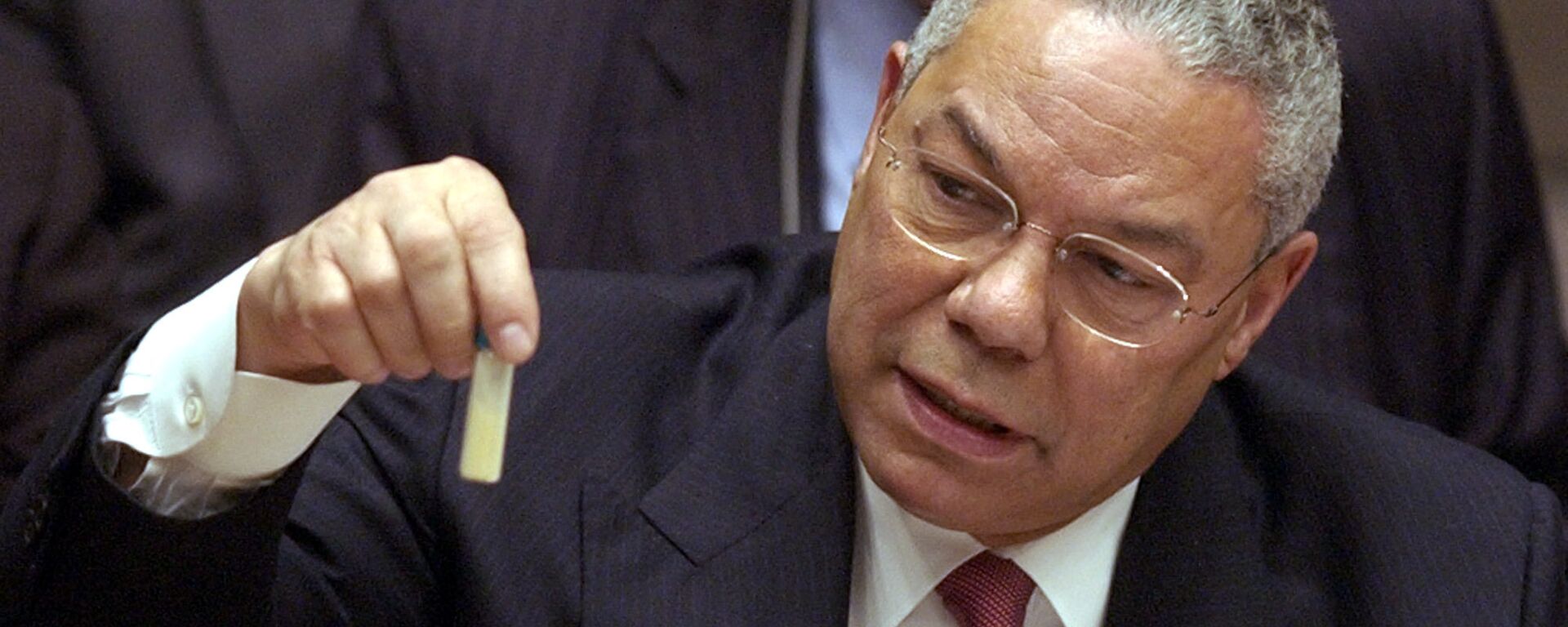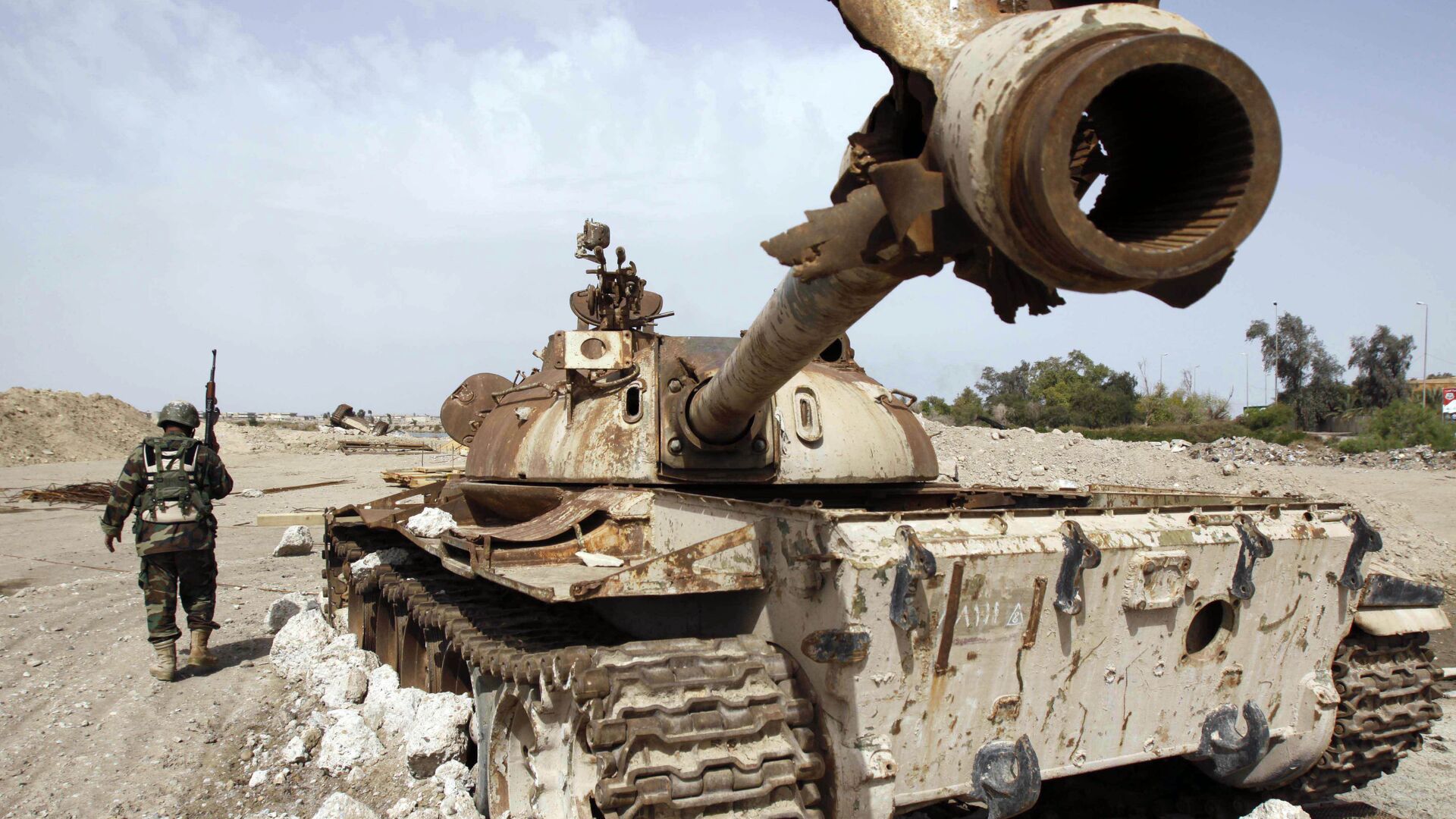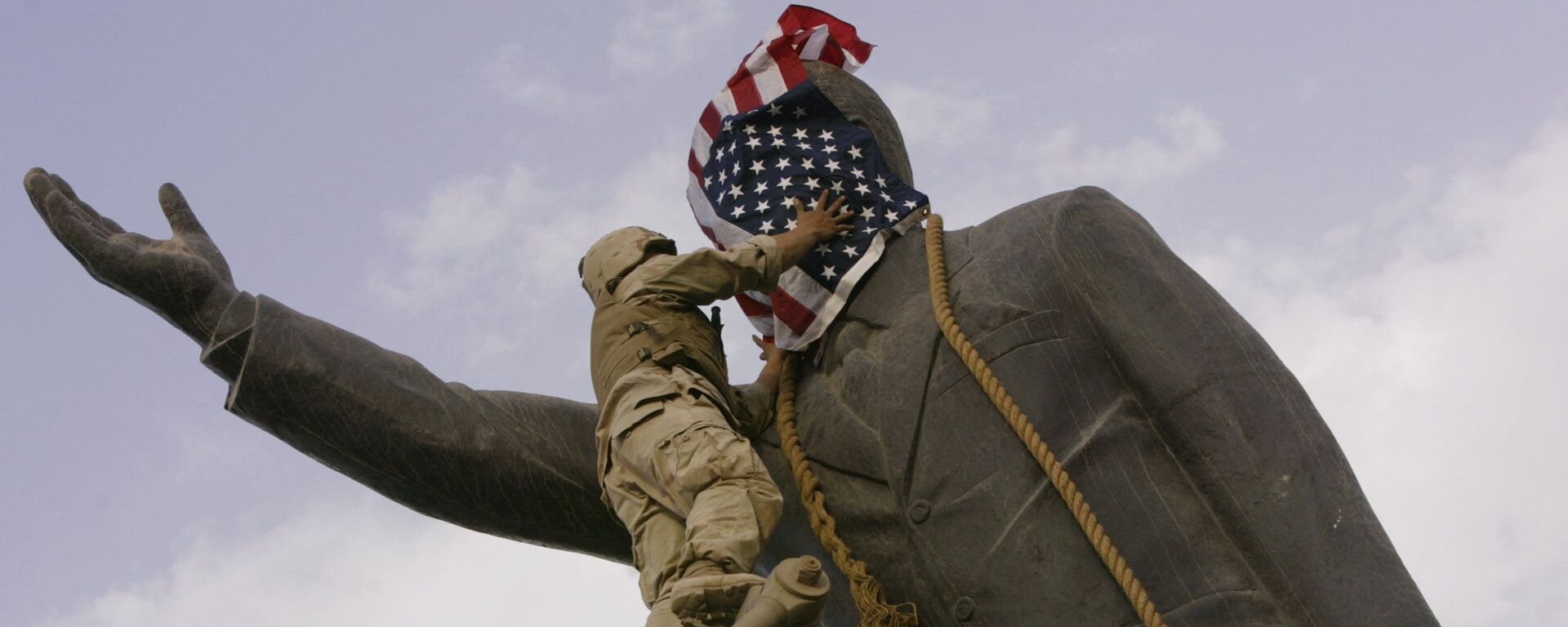https://sputnikglobe.com/20230318/senior-iraqi-military-tells-sputnik-about-american-crimes-during-2003-invasion-of-iraq-1108538945.html
Senior Iraqi Military Officer Tells Sputnik About American Crimes During 2003 Invasion of Iraq
Senior Iraqi Military Officer Tells Sputnik About American Crimes During 2003 Invasion of Iraq
Sputnik International
Decades before the fall of Baghdad, the US nurtured plans to destroy Iraq. Even 20 years after the US invasion of Iraq, the wounds continue to bleed - the... 18.03.2023, Sputnik International
2023-03-18T14:00+0000
2023-03-18T14:00+0000
2023-03-19T10:52+0000
20 years since us invasion of iraq
us
iraq war
iraq
2003 invasion of iraq
interviews
https://cdn1.img.sputnikglobe.com/img/102589/59/1025895969_0:249:4608:2841_1920x0_80_0_0_cb43dd54101b5eaa0e0f34995550d74a.jpg
Sputnik spoke to Brigadier General Ayad al-Tufan, commander of the Iraqi Army's 7th Border Guard Brigade, about the wounds that left an indelible mark on the memory of every Iraqi, military and civilian. His job was to secure a 574-kilometer stretch from the Iraqi-Jordanian border to the middle of the Iraqi-Saudi border. There were 22 border posts: they were the most dangerous areas of confrontation with US troops before they arrived in Baghdad. He witnessed American crimes during the occupation.He dates the beginning of the American invasion not from March 20, as internationally recognized, but from March 17. According to his recollections, it was March 17, 2003, when the first signs of military aggression appeared.Sputnik: Did you expect a ground operation by US troops in Iraq after years of blockade and exhaustion of the army amid active news reports that the country had weapons of mass destruction?Ayad al-Tufan: It would be wrong and short-sighted to say that the American war in Iraq began on March 17, 2003, and ended on April 9. It actually began on August 2, 1990, when the Iraqi army invaded Kuwait. This was the forerunner to all the tragedies Iraq has experienced since leaving the neighboring country.There was a blockade during the whole period after the operation in Kuwait, and it was very tight. And the Iraqi army was the first to suffer, both in terms of training and exercises. Even the air force didn't have a winter or summer training system.Sputnik: What do you think about the arguments and reasons given by the US for going to war against Iraq?Ayad al-Tufan: Time has shown that all the reasons for starting the war were fabricated. And here I would like to quote US Secretary of State [Colin] Powell, who was shaking a test tube during the Security Council meeting. He said that this moment marked the end of his political and military career and that it was the saddest decision he had ever made.Meanwhile, despite claims that they made mistakes, they cannot be considered spontaneous. The US planned the collapse of Iraq.Sputnik: As a commander in the Iraqi army, how did you prepare for the war and what happened after the American ground operation began?Ayad al-Tufan: There was a moment that I want to talk about for the first time: at 2 a.m. on March 17, 2003, two or three hours before the American bombing of Baghdad, two American helicopters flew in from the Ruwayshid Air Base in Jordan and two from a military base in the Arar region of Saudi Arabia. They destroyed all the outposts where the personnel of the 7th Brigade, which I commanded, were stationed.We were forced to withdraw the remaining forces. At the same time, the destroyed outposts were monitoring American reconnaissance operations on the Jordanian and Saudi fronts. And before that, these aircraft had been operating at a certain distance on Saudi and Jordanian territory. We understood that the US aircraft carriers were not moving in the area except to carry out important strategic tasks. We had already observed these movements and realized that war was inevitable.Sputnik: What was going on as the Americans prepared to enter Baghdad?Ayad al-Tufan: US occupation forces used excessive force, using medium and heavy weapons near residential areas in violation of the Geneva Conventions, which prohibit this in time of war.They used all kinds of weapons against the civilian population in order to lower their morale and make them refuse to support the fighting Iraqi army. That is why their bombings targeted not only military installations, but also cities, and because the Americans had already committed massacres in Iraq before 2003.Among them was the so-called ‘Highway of Death’ massacre, when the Iraqi army withdrew from Kuwait under Russian mediation and UN supervision. It resulted in thousands of deaths and the destruction of tens of thousands of pieces of equipment. The airstrikes that followed did not discriminate between military and civilian targets, and many other crimes were committed at the time, especially in the southern and central provinces, which received the bulk of US bombing.”Sputnik: What was it like in the first hours after US troops approached Baghdad?Ayad al-Tufan: By that time, most of the Iraqi troops had been redeployed to neighboring areas, and we had multiple contingency plans for every situation.An important factor that gave the Americans an advantage was the huge difference in weapons. When they could not get through the Umm Qasr sector, they managed to enter the desert near Nasiriyah and As-Samawah until they reached the outskirts of Najaf. Then they reached the Karbala desert and from there to Musayyib and on to Baghdad. Their military equipment provided them with supplies and ammunition.We did not have even the simplest of air defenses in the face of considerable US air superiority. It is fair to say that the tragedy of the blockade had had a negative impact on the Iraqi army in terms of its lack of weapons. Nevertheless, the tenacity that our military showed from March 17 to April 9 was a symbol of the tenacity of the Iraqi soldier defending his country.Sputnik: Did Iraqis greet Americans with flowers, as George W. Bush tried to portray?Ayad al-Tufan: All these rumors had nothing to do with reality and were only spread to break the morale of the Iraqi people and army. The invaders robbed us of our dignity and sovereignty, took the lives of thousands of Iraqis and are still committing atrocities. And their crimes and treachery know no end.And this was not only true of the US forces, but also of the PMCs, who attacked and killed civilians for no reason.How many massacres were committed in the heart of Baghdad? America's atrocities in Iraq are shameful and disgraceful. We saw it in 1991, when they bombed the Amiriyah shelter. And all their crimes confirm that they are an army based on the violation of human rights and the constant humiliation of the weak.”Sputnik: Did you have a plan prepared in advance to defend Baghdad?Ayad al-Tufan: Yes, but the plan to defend Baghdad was limited. Little was known about it, so the Americans quickly moved into Baghdad after arriving at the airport and from there into the government compound.We know that many of the units that were present in the Anbar, Salah Al-Din, and Kirkuk governorates did not fight. After the US troops arrived at the government headquarters, they laid down their weapons because there was no point in fighting anymore.”Sputnik: What are the most serious crimes against humanity committed by US occupation forces since their arrival in Baghdad?Ayad al-Tufan: Perhaps one of the most heinous crimes committed by US troops occurred during the battle for Baghdad Airport. The Iraqis set up a very large ambush there after receiving information that 12 American Chinook helicopters had arrived at the airport full of soldiers.As soon as they landed, the Iraqi soldiers fired a massive electrical charge, incinerating 11 American helicopters and the soldiers on board, and only one managed to escape the trap.During the second battle at the airport, Iraqi fighters managed to capture a large number of soldiers, killing more than 200....The Americans then resorted to the use of chemical weapons that literally melted human flesh. I saw many burnt skeletons with my own eyes. And it looked very strange, especially since the area where the fighting took place was later turned into a no-go zone for all Iraqis.Five years later, US troops issued tenders to deliver soil from outside the city. It was delivered to the Americans, who unloaded the dirt and brought it back. The price per wagon reached $1,000.In order to hide all traces of the chemical weapons crime, the soil in the area was replaced to a depth of 5-10 meters.
https://sputnikglobe.com/20230205/making-the-case-for-war-20-years-ago-colin-powell-lied-to-the-un-1106970009.html
https://sputnikglobe.com/20230317/us-squandered-its-unipolar-moment-by-sowing-destruction-over-last-25-years-1108510611.html
iraq
Sputnik International
feedback@sputniknews.com
+74956456601
MIA „Rossiya Segodnya“
2023
Sputnik International
feedback@sputniknews.com
+74956456601
MIA „Rossiya Segodnya“
News
en_EN
Sputnik International
feedback@sputniknews.com
+74956456601
MIA „Rossiya Segodnya“
Sputnik International
feedback@sputniknews.com
+74956456601
MIA „Rossiya Segodnya“
us, iraq war, iraq, 2003 invasion of iraq, interviews
us, iraq war, iraq, 2003 invasion of iraq, interviews
Senior Iraqi Military Officer Tells Sputnik About American Crimes During 2003 Invasion of Iraq
14:00 GMT 18.03.2023 (Updated: 10:52 GMT 19.03.2023) Decades before the fall of Baghdad, the US nurtured plans to destroy Iraq. Even 20 years after the US invasion of Iraq, the wounds continue to bleed - the Americans have destroyed all the foundations of statehood in the country.
Sputnik spoke to Brigadier General Ayad al-Tufan, commander of the Iraqi Army's 7th Border Guard Brigade, about the wounds that left an indelible mark on the memory of every Iraqi, military and civilian. His job was to secure a 574-kilometer stretch from the Iraqi-Jordanian border to the middle of the Iraqi-Saudi border. There were 22 border posts: they were the most dangerous areas of confrontation with
US troops before they arrived in Baghdad. He witnessed American crimes during the occupation.
He dates the beginning of the American invasion not from March 20, as internationally recognized, but from March 17. According to his recollections, it was March 17, 2003, when the first signs of military aggression appeared.
Sputnik: Did you expect a ground operation by US troops in Iraq after years of blockade and exhaustion of the army amid active news reports that the country had weapons of mass destruction?
Ayad al-Tufan: It would be wrong and short-sighted to say that the American war in Iraq began on March 17, 2003, and ended on April 9. It actually began on August 2, 1990, when the Iraqi army invaded Kuwait. This was the forerunner to all the tragedies Iraq has experienced since leaving the neighboring country.
There was a blockade during the whole period after the operation in Kuwait, and it was very tight. And the Iraqi army was the first to suffer, both in terms of training and exercises. Even the air force didn't have a winter or summer training system.

5 February 2023, 05:00 GMT
Sputnik: What do you think about the arguments and reasons given by the US for going to war against Iraq?
Ayad al-Tufan: Time has shown that all the reasons for starting the war were fabricated. And here I would like to quote US Secretary of State [Colin] Powell, who was shaking a test tube during the Security Council meeting. He said that this moment marked the end of his political and military career and that it was the saddest decision he had ever made.
Meanwhile, despite claims that they made mistakes, they cannot be considered spontaneous. The US planned the collapse of Iraq.
Sputnik: As a commander in the Iraqi army, how did you prepare for the war and what happened after the American ground operation began?
Ayad al-Tufan: There was a moment that I want to talk about for the first time: at 2 a.m. on March 17, 2003, two or three hours before the American bombing of Baghdad, two American helicopters flew in from the Ruwayshid Air Base in Jordan and two from a military base in the Arar region of Saudi Arabia. They destroyed all the outposts where the personnel of the 7th Brigade, which I commanded, were stationed.
We were forced to withdraw the remaining forces. At the same time, the destroyed outposts were monitoring American reconnaissance operations on the Jordanian and Saudi fronts. And before that, these aircraft had been operating at a certain distance on Saudi and Jordanian territory. We understood that the US aircraft carriers were not moving in the area except to carry out important strategic tasks. We had already observed these movements and realized that war was inevitable.
Sputnik: What was going on as the Americans prepared to enter Baghdad?
Ayad al-Tufan: US occupation forces used excessive force, using medium and heavy weapons near residential areas in violation of the Geneva Conventions, which prohibit this in time of war.
They used all kinds of weapons against the civilian population in order to lower their morale and make them refuse to support the fighting Iraqi army. That is why their bombings targeted not only military installations, but also cities, and because the Americans had already committed massacres in Iraq before 2003.
Among them was the so-called ‘Highway of Death’ massacre, when the Iraqi army withdrew from Kuwait under Russian mediation and UN supervision. It resulted in thousands of deaths and the destruction of tens of thousands of pieces of equipment. The airstrikes that followed did not discriminate between military and civilian targets, and many other crimes were committed at the time, especially in the southern and central provinces, which received the bulk of US bombing.”
Sputnik: What was it like in the first hours after US troops approached Baghdad?
Ayad al-Tufan: By that time, most of the Iraqi troops had been redeployed to neighboring areas, and we had multiple contingency plans for every situation.
An important factor that gave the Americans an advantage was the huge difference in weapons. When they could not get through the Umm Qasr sector, they managed to enter the desert near Nasiriyah and As-Samawah until they reached the outskirts of Najaf. Then they reached the Karbala desert and from there to Musayyib and on to Baghdad. Their military equipment provided them with supplies and ammunition.
We did not have even the simplest of air defenses in the face of considerable US air superiority. It is fair to say that the tragedy of the blockade had had a negative impact on the Iraqi army in terms of its lack of weapons. Nevertheless, the tenacity that our military showed from March 17 to April 9 was a symbol of the tenacity of the Iraqi soldier defending his country.
Sputnik: Did Iraqis greet Americans with flowers, as George W. Bush tried to portray?
Ayad al-Tufan: All these rumors had nothing to do with reality and were only spread to break the morale of the Iraqi people and army. The invaders robbed us of our dignity and sovereignty, took the lives of thousands of Iraqis and are still committing atrocities. And their crimes and treachery know no end.
And this was not only true of the
US forces, but also of the PMCs, who attacked and killed civilians for no reason.
How many massacres were committed in the heart of Baghdad? America's atrocities in Iraq are shameful and disgraceful. We saw it in 1991, when they bombed the Amiriyah shelter. And all their crimes confirm that they are an army based on the violation of human rights and the constant humiliation of the weak.”
Sputnik: Did you have a plan prepared in advance to defend Baghdad?
Ayad al-Tufan: Yes, but the plan to defend Baghdad was limited. Little was known about it, so the Americans quickly moved into Baghdad after arriving at the airport and from there into the government compound.
We know that many of the units that were present in the Anbar, Salah Al-Din, and Kirkuk governorates did not fight. After the
US troops arrived at the government headquarters, they laid down their weapons because there was no point in fighting anymore.”
Sputnik: What are the most serious crimes against humanity committed by US occupation forces since their arrival in Baghdad?
Ayad al-Tufan: Perhaps one of the most heinous crimes committed by US troops occurred during the battle for Baghdad Airport. The Iraqis set up a very large ambush there after receiving information that 12 American Chinook helicopters had arrived at the airport full of soldiers.
As soon as they landed, the Iraqi soldiers fired a massive electrical charge, incinerating 11 American helicopters and the soldiers on board, and only one managed to escape the trap.
During the second battle at the airport, Iraqi fighters managed to capture a large number of soldiers, killing more than 200....
The Americans then resorted to the use of chemical weapons that literally melted human flesh. I saw many burnt skeletons with my own eyes. And it looked very strange, especially since the area where the fighting took place was later turned into a no-go zone for all Iraqis.
Five years later, US troops issued tenders to deliver soil from outside the city. It was delivered to the Americans, who unloaded the dirt and brought it back. The price per wagon reached $1,000.
In order to hide all traces of the chemical weapons crime, the soil in the area was replaced to a depth of 5-10 meters.







